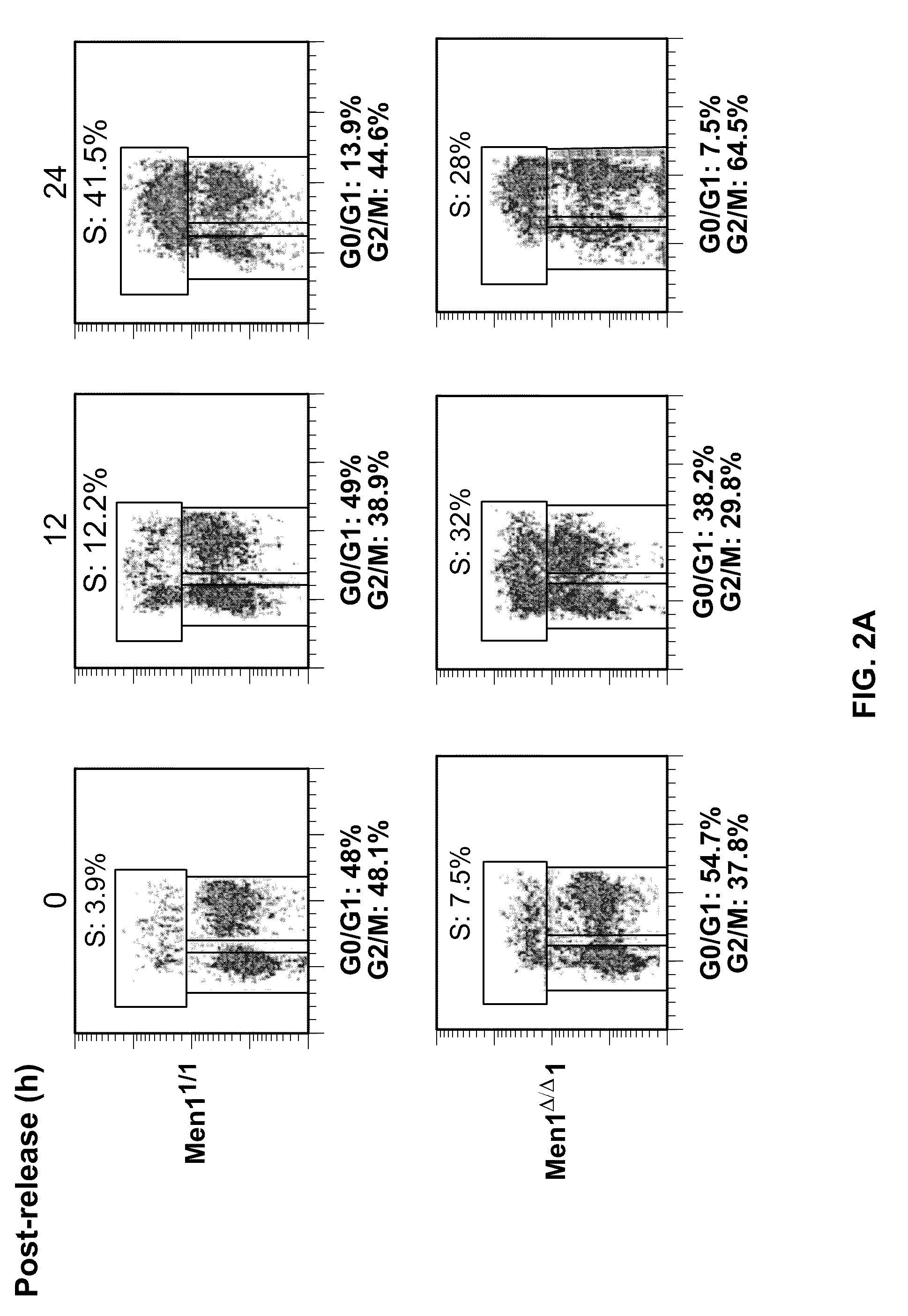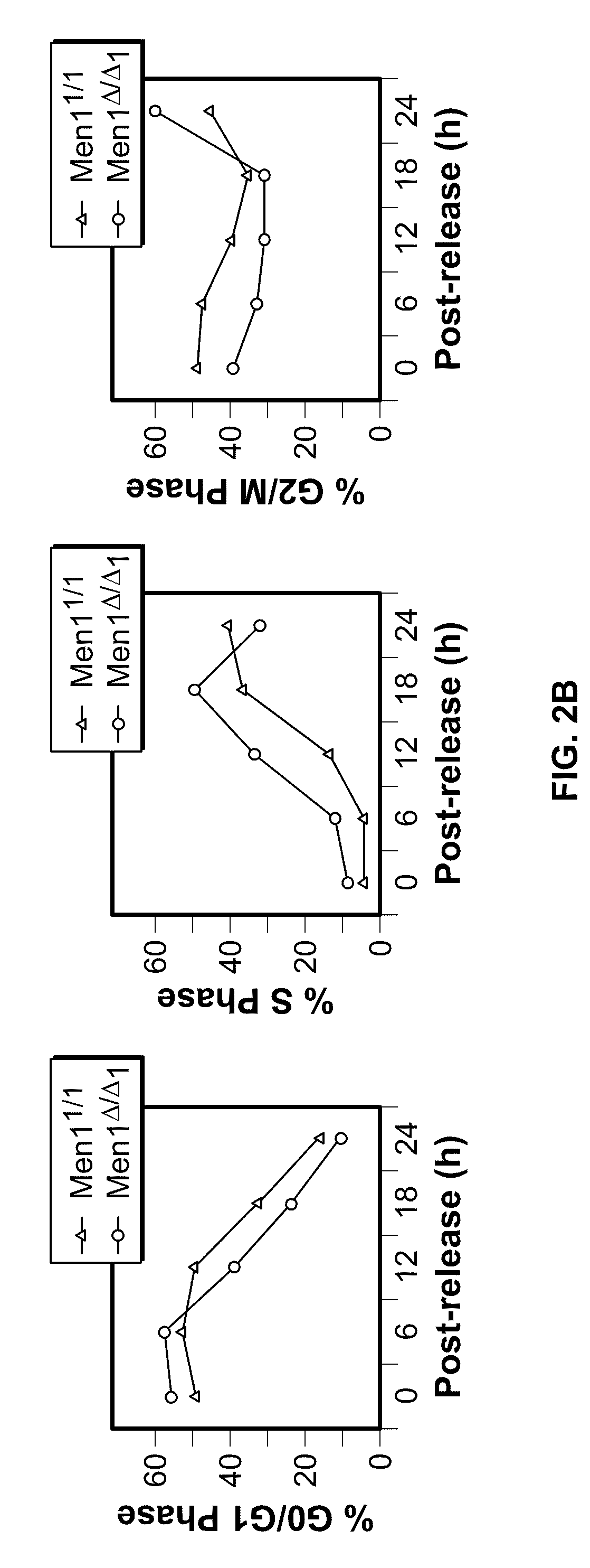Men1 gene for diagnosis and treatment of diabetes
a technology of men1 and diabetes, applied in the field of men1 gene for diagnosis and treatment of diabetes, can solve the problems of difficult to study the acute effect of deletion of men1 on the proliferation of pancreatic islet cells, the state of impaired glucose tolerance develops, and the difficulty of determining how to achieve the effect of reducing blood sugar level and increasing insulin production
- Summary
- Abstract
- Description
- Claims
- Application Information
AI Technical Summary
Benefits of technology
Problems solved by technology
Method used
Image
Examples
example 1
Ablation of Men1In Vitro Increases Cell Proliferation and Transition from G0 / G1 to S Phase
[0142]MEFs from mouse embryos were immortalized with the floxed Men1 using the 3T9 protocol, and then infected the cells with recombinant adenoviruses expressing either GFP (Ad-GFP) or Cre (Ad-Cre) that could excise the floxed Men1 from the genome. The cell lysates from the infected cells were subjected to Western blotting analysis. Ad-Cre (lanes 2 and 3), but not Ad-GFP (lane 1), abrogated expression of menin (FIG. 1A). Men1 excision was also confirmed by genotyping (FIG. 1B) because Men1 excision yielded a PCR fragment of the increased size. The Men1Δ / Δ1 cells and the Men1Δ / Δ2 cells, two independent pools of the MEFs infected by Ad-Cre, proliferated more quickly than the menin-expressing Men11 / 1 cells (2.7 and 2.9×106 versus 1.3×106 cells; P1 / 1 versus Men1Δ / Δ1; P1 / 1 versus Men1Δ / Δ2; FIG. 1C). To further confirm this difference in cell proliferation in vitro, Men11 / 1 was excised from one addit...
example 2
Ablation of Men1Increases Cdk2 Activity But Decreases p18Ink4c and p27Kip1 RNA and Protein Levels
[0144]The cell cycle is positively regulated by various CDKs and CDK2 plays a crucial role in controlling G0 / G1 to S transition. Thus, a determination whether menin inhibits CDK2 activity was made. Lysates from Men11 / 1 cells and Men1Δ / Δ1 cells, at various time points of cell cycle progression, were immunoprecipitated with an anti-CDK2 antibody, and the precipitated kinase activity was detected using histone H1 as a substrate. FIG. 3A (top) shows that CDK2 activity, as indicated by the amount of phosphorylation of histone H1, increased after Men1 was excised (lanes 5-7). Quantification of phosphorylation shows that the CDK2 activity was 2-fold higher in Men1Δ / Δ1 cells than in Men11 / 1 cells at each corresponding time point (FIG. 3A, bottom). Menin expression did not alter the phosphorylation of the inhibitory Y15 residue nor the activating T160 residue of CD 2 This result suggests that los...
example 3
Complementation of Men1Δ / Δ1 Cells with Wild-Type Menin Inhibits Cell Proliferation and G0 / G1 to S Phase Progression and Restores p18Ink4c and p27Kip1 Protein and RNA Levels
[0146]If Men1 excision leads to enhanced cell proliferation and G0 / G1 to S phase transition, complementation of menin-null cells with menin should suppress cell proliferation and G0 / G1 to S phase progression. Thus, Men1Δ / Δ1 cells was infected with control vector retroviruses or retroviruses encoding wild-type menin, and the resulting cells were monitored for cell growth, expression of p18Ink4c and p27Kip1, and G0 / G1 to S progression. By day 4, there were 2.5×106 vector-complemented cells versus 1.3×106 menin-complemented cells (FIG. 4A); these differences were significant (PInk4c and p27Kip1 was higher in menin-complemented cells than in vector complemented cells at both the protein and mRNA (FIGS. 4B and C) levels, consistent with a previous report that menin is crucial for optimal expression of p27Kip1 (PInk4c (...
PUM
| Property | Measurement | Unit |
|---|---|---|
| pH | aaaaa | aaaaa |
| body weight | aaaaa | aaaaa |
| time | aaaaa | aaaaa |
Abstract
Description
Claims
Application Information
 Login to View More
Login to View More - R&D
- Intellectual Property
- Life Sciences
- Materials
- Tech Scout
- Unparalleled Data Quality
- Higher Quality Content
- 60% Fewer Hallucinations
Browse by: Latest US Patents, China's latest patents, Technical Efficacy Thesaurus, Application Domain, Technology Topic, Popular Technical Reports.
© 2025 PatSnap. All rights reserved.Legal|Privacy policy|Modern Slavery Act Transparency Statement|Sitemap|About US| Contact US: help@patsnap.com



